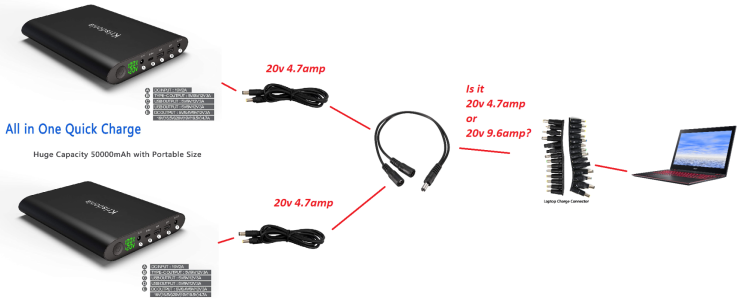An Aberrant Person
n00b
- Joined
- Sep 24, 2021
- Messages
- 52
I have 2 backup batteries that can run at various voltages. Assume these 2 scenarios for 12v and 19/20v.
Can I use this cable below to run 2 power sources of equal volts in parallel to double the maximum amp limit and run time? For the 12v option which is the max amps?
Split power cable
https://smile.amazon.com/dp/B07F5VW...olid=2EKNW43BVT70W&psc=1&ref_=lv_ov_lig_dp_it
battery pack 1
https://www.ebay.com/itm/373708300350?nma=true&si=ZR4H9va8v%2Bi%2BEoA0Nc9KopIIwQA%3D&orig_cvip=true&nordt=true&rt=nc&_trksid=p2047675.l2557
battery pack 2
https://smile.amazon.com/dp/B07RNZZ...olid=1Z82TV3H4UG33&psc=1&ref_=lv_ov_lig_dp_it
freezer
https://smile.amazon.com/gp/product/B07MGXQY3V/ref=ppx_yo_dt_b_search_asin_title?ie=UTF8&psc=1
Laptop
https://www.newegg.com/black-obsidi...1-887w/p/N82E16834316267?Item=N82E16834316267
I attached a diagram for simplicity.
I appreciate any and all help. Thanks!
Can I use this cable below to run 2 power sources of equal volts in parallel to double the maximum amp limit and run time? For the 12v option which is the max amps?
Split power cable
https://smile.amazon.com/dp/B07F5VW...olid=2EKNW43BVT70W&psc=1&ref_=lv_ov_lig_dp_it
battery pack 1
https://www.ebay.com/itm/373708300350?nma=true&si=ZR4H9va8v%2Bi%2BEoA0Nc9KopIIwQA%3D&orig_cvip=true&nordt=true&rt=nc&_trksid=p2047675.l2557
battery pack 2
https://smile.amazon.com/dp/B07RNZZ...olid=1Z82TV3H4UG33&psc=1&ref_=lv_ov_lig_dp_it
freezer
https://smile.amazon.com/gp/product/B07MGXQY3V/ref=ppx_yo_dt_b_search_asin_title?ie=UTF8&psc=1
Laptop
https://www.newegg.com/black-obsidi...1-887w/p/N82E16834316267?Item=N82E16834316267
I attached a diagram for simplicity.
I appreciate any and all help. Thanks!
Attachments
As an eBay Associate, HardForum may earn from qualifying purchases.
![[H]ard|Forum](/styles/hardforum/xenforo/logo_dark.png)

